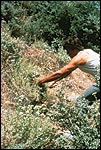Home | FOOD ARTICLES | Food Trivia | Today_in_Food_History | Food_History_Timeline | Recipes | Cooking_Tips | Food_Videos | Food_Quotes | Who’s_Who | Culinary_Schools_&_Tours | Food_Trivia_Quizzes | Food_Poems | Free_Magazines | Food_Festivals_and_Events
Food Articles, News & Features Section
FREE Magazines
and other Publications
Free Professional and Technical Research, White Papers, Case Studies, Magazines, and eBooks
OREGANO FIELD REPORT
See also: Oregano Trivia
Spice Buyer's Journal:
The Mediterranean & Mexico
My name is Al Goetze, and I’m the chief spice buyer at McCormick. Together, my team and I have more than 100 years of spice-buying experience. We spend the bulk of our time scouring more than 30 countries worldwide in search of the finest quality herbs and spices. We visit some of the most remote and interesting places in the world.
Let’s begin by taking a look at oregano. The harvest was completed a couple of months ago, and the pick of the latest crop will soon arrive on your grocer’s shelves. This year’s harvest was plentiful, predominantly due to favorable weather conditions. We selected both Mediterranean (Turkish) and Mexican oregano – the most popular varieties of the herb. Each has a distinctly different flavor, with Mediterranean being the more familiar favorite found in pizza, pasta sauces and Italian dishes. Both types can flavor a variety of foods -- Greek, Italian, Middle Eastern, Mexican, and more -- yet few people stop to think where oregano comes from or how it became so indispensable to our favorite meals.
Charting the Mediterranean Our journey commences near the Aegean Sea, where oregano has grown in the wild for thousands of years. Here, the plant, whose name is derived from the Greek, “oros ganos” (joy of the mountain), is grown among the rocks –- literally in the mountains or hill country -- often far away from towns and villages. Mediterranean oregano gained popularity in the United States after the troops who were stationed in Italy returned home from World War II. It is strongly aromatic and somewhat bitter with a slight mint-like essence.
Our journey commences near the Aegean Sea, where oregano has grown in the wild for thousands of years. Here, the plant, whose name is derived from the Greek, “oros ganos” (joy of the mountain), is grown among the rocks –- literally in the mountains or hill country -- often far away from towns and villages. Mediterranean oregano gained popularity in the United States after the troops who were stationed in Italy returned home from World War II. It is strongly aromatic and somewhat bitter with a slight mint-like essence.
Mediterranean oregano is a small plant, Origanum vulgare , which grows to about two to three feet tall. The herb flourishes during the rainy season, which typically begins in March and lasts through the spring. In June and July, the oregano is hand harvested and sun dried. This drying process usually takes place in the backyards of the villagers who harvest the plant. Because harvesting is such a painstaking process -- trekking out to the hills and hand-cutting the plants -- some villagers have created “short cuts” to help stretch the volume of their harvest. They may try to add similar looking green plant material into the bags they bring to market. To offset this issue, my team and I have developed a stringent set of standards and tests to ensure that the oregano we sell is 100% pure.
Because harvesting is such a painstaking process -- trekking out to the hills and hand-cutting the plants -- some villagers have created “short cuts” to help stretch the volume of their harvest. They may try to add similar looking green plant material into the bags they bring to market. To offset this issue, my team and I have developed a stringent set of standards and tests to ensure that the oregano we sell is 100% pure.
Heading South of the Border
Next stop - Mexico, the undeveloped, mountainous countryside - to inspect the crop there. Mexican oregano, Lippia graveolens or Lippia berlandieri, has a stronger, more robust and less mint-like flavor than Mediterranean oregano. This is because it is a different species. In fact, the plant even looks completely different from its Mediterranean cousin. The Mexican oregano plant resembles a four to six-foot tall bush, with leaves that curl up when dried. Because of this key characteristic, many spice traders refer to Mexican oregano as “curly leaf oregano.” It is commonly found in chili powder and its flavor is best suited to authentic Mexican foods such as sauces, meat and bean dishes, and chili. Mexican oregano grows similar to that of Mediterranean oregano - in the wild during the spring and throughout the rainy season. It has a slightly longer growing season than Mediterranean oregano, and is traditionally harvested during the months of August, September and October.
Mexican oregano grows similar to that of Mediterranean oregano - in the wild during the spring and throughout the rainy season. It has a slightly longer growing season than Mediterranean oregano, and is traditionally harvested during the months of August, September and October.
We hope you’ve enjoyed this season’s journey, and look forward to bringing you more spice buyers’ journals during the year.
About McCormick
McCormick was founded in 1889 in Baltimore, Md. Today it is the largest spice company in the world. McCormick sources only the finest ingredients from around the globe to bring the highest quality flavors to consumers. For more information, visit McCormick online at www.mccormick.com, or call 1-800-MEAL-TIP (1-800-632-5847).
RELATED ARTICLES
Please feel free to link to any pages of FoodReference.com from your website.
For permission to use any of this content please E-mail: james@foodreference.com
All contents are copyright © 1990 - 2025 James T. Ehler and www.FoodReference.com unless otherwise noted. All rights reserved.
You may copy and use portions of this website for non-commercial, personal use only.
Any other use of these materials without prior written authorization is not very nice and violates the copyright.
Please take the time to request permission.

